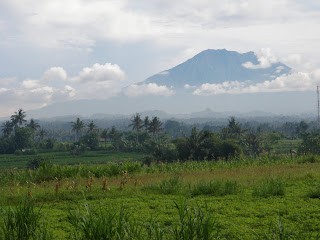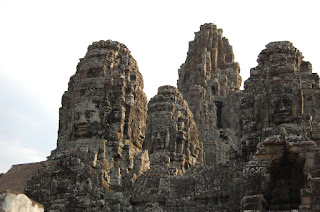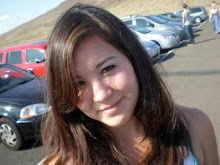

Wow, Bali is amazing. It’s kind of hard to explain, but somewhere between the laidback island feel, the beautiful scenery, the traditional dress and customs everywhere, and the friendliness of the people, it’s really hard not to love. Bali has a lot of places to go for being a relatively small island. The main attraction is Kuta beach, which has great surfing and white sand beaches and also now has a plethora of bars, malls and stores as well as sun burnt tourists. Another popular place to visit on the island is called Ubud, and is more of a cultural center with a lot of Hindu temples and kind of a small town feel, although it’s also clearly been changed by tourism. Tara and I decided we’d skip the beach scene and spend our time in Ubud, which is up in the hills near the center of the island, about an hour drive from Denpasar and Kuta. I was so excited to see her walk out of the airport and catch up, that we talked for an hour standing in the receiving area and barely noticed that the guy picking us up from the hotel was very late. When I was booking hotels for this part of the trip, I was looking for budget places, and we were expecting to be in kind of a dirty, slightly uncomfortable place, so the brand new, leather seated car that picked us up was a bit confusing. When we pulled up at the hotel itself (called Taman Harum) we were sure that there had been some mistake. The outside was beautiful traditional stonework and carving. We were led through a pathway lined with hibiscus flowers and overflowing greenery, passing a beautiful infinity pool that overlooked rice paddies, to a covered check in area where they fed us tropical juice. After we checked in, we were led further down the pathway, past little cottages, to a slightly larger building, where up the stairs we were faced with a huge, intricately carved and painted, Balinese style wooden door. Our room was huge, with two twin beds, air conditioning, free bottles of water, and a large bathroom with a western style toilet and hot shower. It also included a nice American breakfast of eggs, ham, toast, fruit, and coffee every morning and free rides into Ubud (about 10 mintues away) whenever we wanted. We really hit the jackpot. This place was 40 US dollars per night.


We decided we didn’t want to waste any time, so after checking in we asked to be taken into Ubud to grab dinner and see a dance show. We had a nice meal at a place near Ubud Palace, which is where the dance was to be performed, that included the famous “Gado-gado,” a vegetable dish with peanut sauce and rice. Bali has a lot of traditional dance forms, and the one we saw was called “Legong.” It was very interesting and completely different from anything either of us had seen before. The music accompanying it is kind of a repetitive, metallic/xylophone pattern, with a quiet flute melody. The dancing is very other worldly, with quick, flipping of the hands, shimmying of the shoulders, and shuffling of the feet. One of the things that stands out the most is the facial expressions and eye movements of the dancers. The female dancers keep their eyes very wide open, and quickly switch the direction they’re looking along with the beat of the music (picture one of those cat clocks where the tail and the eyes tick back and forth). The best description we could come up with for the facial expression that they very impressively held for the whole dance was kind of a gangster “She said WHATTTT?!” face. They wore beautiful traditional costumes and hats. We didn’t really get the story, but it seemed to go something like this: A beautiful princess dances with her two attendants. A large dragon dog comes out and plays with some monkeys and a banana. Four large kings come out and look very concerned and dance around with each other. Then, four comical men come out and have some sort of dialog, after which the princess appears again with many more attendants. Later there are two larger kings who come out and argue about who gets to have the princess. She dances some more after they leave, and then the dog comes back out, along with the comical men and they all dance together. Clearly I missed the point, but it was very nice to watch anyway.
The next morning, we got up and went into Ubud to walk around and have lunch. It’s very pretty, with Hindu temples on almost every block, and little artsy stores lining narrow roads that wind up towards the center of the town. The people are very friendly and relaxed, mostly wearing traditional style clothes like sarongs, and head scarves. We were surprised to find that almost everyone we met spoke English very well. Apparently they start learning it in elementary school, and continue up through secondary school and some in university. People walk up and down the streets, carrying their loads on their heads, cushioned by their headscarves and sometimes small towels. Along every sidewalk and ledge there are little offerings that they put out periodically throughout the day with fruit, flowers, incense, and little grass woven holders. We shopped for a while and had a nice lunch, brownie, and “detox” smoothie, and then headed back to the hotel. As soon as we got back, it promptly started torrential down pouring - flooding the walkways with huge fat raindrops that would soak you immediately if you stood outside. We decided to stay in that night, have dinner at our hotel, and go for a warm swim when the rain stopped.


The next morning, we woke up early and hired a local guide to take us on an advertised “Nature Walk.” He took us first on about a two hour walk through nearby rice paddies. Although it was a bit muddy, and the “path” often involved scooting over tiny bridges and jumping over ditches, it was cool because our guide had grown up in the area and his father was still a farmer there. He pointed out birds and snakes to us, and explained just about every plant we passed, telling us to smell their leaves and saying what they were used for in medicine, food, or tradition. It was beautiful and green, and we could see Bali’s big volcano in the distance. It was also extremely hot, and we were relieved to come to the end of the walk at his father’s hut with fresh coconuts to drink. After that he took us to see a pretty black sand beach, a waterfall, and a few little local craftsman stores selling batik, silver, and paintings. He was a very interesting character – extremely forward - and had apparently met Obama when he came to Indonesia. By the end we were pretty worn out, so we went back to shower and eat lunch. We had made friends with one of the drivers at our hotel named Balik, who had offered to take us to see Kuta for a cheaper price than the hotel charged, so we agreed to go with him around 5, and decided to make a last run to Ubud to get some souvenirs. As soon as we got into town, it started down pouring again turning the streets into rivers. Although we bought an umbrella, by the time we got picked up we were pretty drenched. Despite that, we got back and quickly got ready to go check out Kuta. Balik was a very interesting person. He has a car and two motorcycles and lives nearby with his parents. He said he went to university to study Tourism, and has been to Japan to visit his sister, who married a Japanese man and now does Indonesian dance in Tokyo. He drove us down to Kuta, proudly playing his top 40 hits American music CD and teaching us some Balinese words. When we got there, he took us to a mall that faces the ocean, where we were able to catch the last part of the sunset. He ended up hanging out with us there, and going to dinner with us at an Indonesian food place in the mall. We walked around and shopped a little afterwards, and then he drove us back. We paid him for the rides even though he insisted that we shouldn’t, but we figured we got a good deal – a cheap door to door ride, nice dinner, and new friend. He told us next time we come to Bali he’ll show us all the amazing things we missed this time. Kuta was nice, and we’re glad we saw it, but also glad we didn’t stay there. It almost felt like it could be in Florida.


This morning we sadly packed up after our delicious breakfast and left our paradise, promising them all we’d be back someday. Luckily our flight did not fall out of the sky, and we got into Yogyakarta around noon. It’s very hot here and the vibe is definitely different from Bali, so it’ll be exciting to see other ways in which it is different. Our hotel is called Setia Kawan, and we decided to upgrade from 15$ per night to 25 so we can have hot water showers and AC. Tough life . Anyway, now that we’re all cooled off, we should probably go explore the city. Talk soon!




































